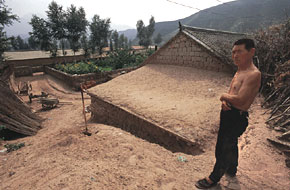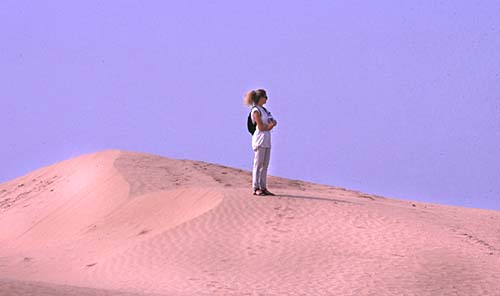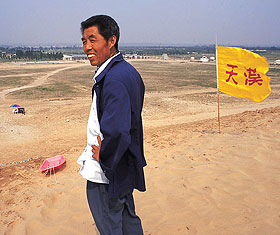Beijing's Desert Storm
The desert is sweeping into China's valleys, choking rivers and consuming precious farm land. Beijing has responded with massive tree-planting campaigns, but the Great Green Walls may not be able to buffer the sand, which could cover the capital in a few years
By Ron Gluckman /Beijing, Fengning and Langtougou, China
FROM HIS ROOFTOP, Su Rongxi maintains an unsteady balance, perched between the past and a precarious future. One foot is planted firmly upon his tiled roof. The other sinks ankle-deep into a huge sand dune that threatens to engulf his house and Langtougou village, where his ancestors have lived for generations. For this dirt-poor town in Hebei province, the sands of time aren't just a quaint notion, they are close at hand, burning the eyes and lungs. And for Langtougou, the sands seem to be ticking out.
 "We have no money to move and, besides, who would have us?" says
Su. "There's nothing to do but dig away the sand and wait to see what
happens. Sometimes I dream of the sand falling around me faster than I can dig
away. The sand chokes me. I worry that in real life, the sand will win."
"We have no money to move and, besides, who would have us?" says
Su. "There's nothing to do but dig away the sand and wait to see what
happens. Sometimes I dream of the sand falling around me faster than I can dig
away. The sand chokes me. I worry that in real life, the sand will win."
Su and his neighbors are ethnic Manchurians who survive by cultivating
subsistence crops and raising horses, goats and pigs. But this year violent
sandstorms dumped entire dunes into the once-fertile Fengning county valley. Now
most of the grass is gone and the Chaobai River stands dry. Besieged villagers
say they have no idea where the sand came from. The scary bit? Su's
almost-buried house is nowhere near the heart of China's rapidly encroaching
deserts. It is just 160 km north of Beijing. Suddenly, rural Langtougou has
become a barren outpost on the front line of a national battlefield.
Premier Zhu Rongji raised the war cry in this very village in May, after the
worst sandstorms in memory buffeted Beijing. Zhu stood on Su's roof, pledging
urgent measures to combat the encroaching sand. Then the premier left with his
entourage, a huge government caravan, on 1,000-kilometer safari across China's
desert hotspots. The next month newspapers ran daily stories about
desertification as armies of tree-planters were mobilized. The 5th Plenum of the
Communist Party Central Committee, starting Oct. 9, has put the issue near the
top of its agenda. Zhu has called it "an alarm for the entire nation."
Su, 53, missed that address — and the visiting premier. Su was in the
grass-stripped hills tending his hungry goats. He doesn't know much about the
goings-on in Beijing anyway, having never traveled further than Fengning's
county seat, about 25 kilometers away. That trip used to take 40 minutes; now it
can last days. Local workers cleared a path for the premier, yet just weeks
later the road vanished — reclaimed by the relentless desert.
Few people think of China as a desert nation, yet it is among the world's
largest. More than 27%, or 2.5 million square kilometers, of the country
comprises useless sand (just 7% of Chinese land feeds about a quarter of the
world's population). A Ministry of Science and Technology task force says
desertification costs China about $2-3 billion annually, while 800 km of railway
and thousands of kilometers of roads are blocked by sedimentation. An estimated
110 million people suffer firsthand from the impacts of desertification and, by
official reports, another 2,500 sq km turns to desert each year.
This is nothing new, of course. In the 4th century B.C. Chinese philosopher
Mencius (Mengzi) wrote about desertification and its human causes, including
tree-cutting and overgrazing. Experts argue over the reasons and consequences,
but all agree that Chinese deserts are on the move. Sand from the distant Gobi
threatens even Beijing, which some scientists say could be silted over within a
few years. Dunes forming just 70 km from the capital may be drifting south at
20-25 km a year. Conservative estimates say 3 km a year. And despite massive
spending on land reclamation and replanting, China is falling behind.
In the
northwest, where the biggest problems lie, desertification has escalated from
1,560 sq km annually in the 1970s to 2,100-2,400 sq km in the 1990s. According
to many environmentalists, Beijing has been largely content to issue
proclamations about student-supported tree-planting rather than tackle
complicated land issues.
But that was before clouds of grit roared through the capital this spring.
Sandstorms are hardly novel in Beijing, but the sheer ferocity of these tempests
was. For days on end, wave after fearsome wave, sand closed the airport and
casualties filled hospitals. Just as surprising was the public outrage. Even
state-run media lambasted government officials. The frustration is easy to
understand. According to Chinese records, dust storms came to the capital once
every seven or eight years in the 1950s, and only every two or three years in
the 1970s. But by the early 1990s, they were an annual problem.
The government
responded with huge "greening" campaigns and in the past 20 years
alone, according to the People's Daily, more than 30 billion trees have been
planted. This year, however, the storms blew away any sense of security.
 Grasping the enormity of the problem is easy on the road north from Beijing to
Langtougou. Nestling among fields of corn and sunflowers, villages bloom with
flowers. After two hours' driving, the views are still green. But over one steep
mountain a surreal landscape astounds the eyes. Mountains rise on both sides of
the valley ahead, but the hills are an ugly gray, denuded of vegetation. Even
weirder, hillsides are dotted with white, much like highway stripes stretching
into the horizon.
Grasping the enormity of the problem is easy on the road north from Beijing to
Langtougou. Nestling among fields of corn and sunflowers, villages bloom with
flowers. After two hours' driving, the views are still green. But over one steep
mountain a surreal landscape astounds the eyes. Mountains rise on both sides of
the valley ahead, but the hills are an ugly gray, denuded of vegetation. Even
weirder, hillsides are dotted with white, much like highway stripes stretching
into the horizon.
The real shock hits on the descent into the valley. Those dots
are actually white-painted stones, lining small pockets of soil. Inside each is
a tiny tree. But the entire countryside has been stripped of grasses, topsoil
and mature trees — meaning the saplings have little chance of survival.
In Langtougou, residents are mumbling about new regulations as they dig huge
pits in their yards to compost manure and waste to produce fuel. Each house must
have one as part of a government decree against burning wood. Firewood
collection (32.4%) is a key cause of desertification in northern China,
according to a study by Chinese researcher Ning Datong and published by the
University of Toronto. Ning attributed the other causes to excessive grazing
(30%) and over-cultivation (23.3%).
None of the 200 villagers is enthusiastic
about their new composting brief, but what really upsets them are the other
initiatives. Farming will cease, and they have also been told they will have to
give up their animals. "This is how we live," says Li Guoyun, 50.
"We have 50 to 60 goats. We sell the wool and some for food. Without them,
we'll be ruined." Li realizes, of course, that his goats gobble up the
grass that used to cover the valley floor and hillsides, "but they are so
much easier than pigs or cows."
Up and down the silted-in valley, the story is much the same. "I grow corn,
rice, beans and tomatoes, to eat and to sell," says Zhang Baoguan, 43, a
father of two from the nearby hamlet of Caonianguo. "Now, I'll have to
stop. The government is promising some rice and money, but it's not
enough." The moratorium on farming and grazing will apply throughout the
valley — and nobody knows for how long.
Villagers have already been drafted into China's new green army of tree-planters. "We'll plant trees every day for five years," Zhang says dejectedly. "And if that doesn't work, we'll plant for five more. That's what they tell us."
Neighbor Lin Renrui
fears that no amount of tree-planting will bring the valley back to life, since
the government has no plans for the sand. "We don't like this plan at all
— especially the part about the animals," Lin says. "The government
told us we will have to sell them all." And the sand? "That's the real
problem," he says, "not the goats. We ask about the sand. Nobody gives
us an answer."
Environmentalists in the capital, most of whom speak on the condition of
anonymity, say Beijing is missing the big picture. Land and water use,
grasslands and forests, desert and climate changes are all interconnected.
"The response has really been fragmented," says one. Yet now that the
government seems to be throwing its weight behind the issue, some critics call
it overkill. "All of a sudden all you read about is desertification,"
says one foreign observer. "You have to wonder if it's not all propaganda,
designed perhaps to win overseas funding for environmental campaigns."
But
what about all that sand, sweeping down from the Gobi Desert and threatening to
swallow Beijing within a few years. "Silly," responds one official in
the Ministry of Agriculture's ecology section. "There are real problems,
but everything with desertification is exaggerated." He worries that the
current focus misses the step-by-step approaches needed in a well-rounded
environmental package. These include planting grasses first to stabilize and
enrich soil, then trees. "But everything is going fast now and there is no
masterplan."
 If ever there is a place to grasp the climatic and environmental changes in
China, it is not out on the vast plains, where herdsmen and farmers battle over
dwindling water resources and tillable land. Instead, it is along an odd stretch
of towering sand dunes just 70 km northwest of the capital. In olden times, this
area was a favorite hunting ground of the imperial family, with forests and
lakes for picnics.
If ever there is a place to grasp the climatic and environmental changes in
China, it is not out on the vast plains, where herdsmen and farmers battle over
dwindling water resources and tillable land. Instead, it is along an odd stretch
of towering sand dunes just 70 km northwest of the capital. In olden times, this
area was a favorite hunting ground of the imperial family, with forests and
lakes for picnics.
Now the woods are gone. Nearby sits the junction town of
Huailai — except that no one calls it that anymore. Even on the road signs it
is Shacheng — Sand City.
The changes also are stark in small villages such as Chai Yuan (Firewood
Garden), about 25 km further northwest. From there it is just a few more
kilometers to Flying Camel Desert, so named because some Chinese entrepreneurs
have surrounded the sand with a fence and charge admission to tourists wishing
to experience the desert. Not that it is much of a desert experience. There are
dune buggies and motor bikes for careering over the dunes, a mock Mongolian
yurt, and camels and Mongolian horses.
Still, there is more at the Flying Camel than exists over the dunes, where huge
waves of sand crash to a halt above Longbaoshan. The village of 800 people was
set up in 1989 to house mountain folk — moved from nearby hills as part of a
resettlement program. The new brick buildings seem impressive, but the village
lacks life. "Nobody has any work," explains Zhang Wengui, 78. "We
grow crops, some fruit and vegetables, that's about all."
At least, that was about all. When farming was banned by Premier Zhu, officials
swept in with their own version of Desert Storm. They introduced a
desertification rehabilitation program, which, thus far, has consisted largely
of fencing in the nearby sand and erecting signs proclaiming: "Controlling
the Desert, State Focus Point." The farming prohibition was mostly a waste
of time as well. Crops wilted long ago.
"We have no water," says Zhang. The two village wells, dug deeper each year, have run dry. The people will likely need to be moved again. In the meantime, no prizes for guessing what they have been doing: planting trees.
 "It's part of a big campaign,"
says one villager, who recalls how the local Bank of China staffers joined in
one day. They had no choice. "The officials just went in and told
everybody: 'You have to plant trees today.'"
"It's part of a big campaign,"
says one villager, who recalls how the local Bank of China staffers joined in
one day. They had no choice. "The officials just went in and told
everybody: 'You have to plant trees today.'"
It is a similar picture in thousands of villages across China, where population
growth has meant rampant farming and wasteful irrigation. Yet if mass
tree-plantings register far below the raging-success mark in Beijing's piecemeal
fight to stave off the sands, they still look pretty good next to the efforts at
Flying Camel Desert.
While Longbaoshan villagers go thirsty, workers at the desert park are busy hosing down a dune so tourists can take a toboggan ride.
Ron Gluckman is an American reporter who is based in Hong Kong and Beijing, but who roams around Asia for a number of different publications including Asiaweek, which ran this Inside Story in October 2000.
Top two pictures courtesy of Ricky Wong, a Hong Kong photographer based in Beijing. Bottom two photos by Ron Gluckman.
To return to the opening page and index
push here
[right.htm]
